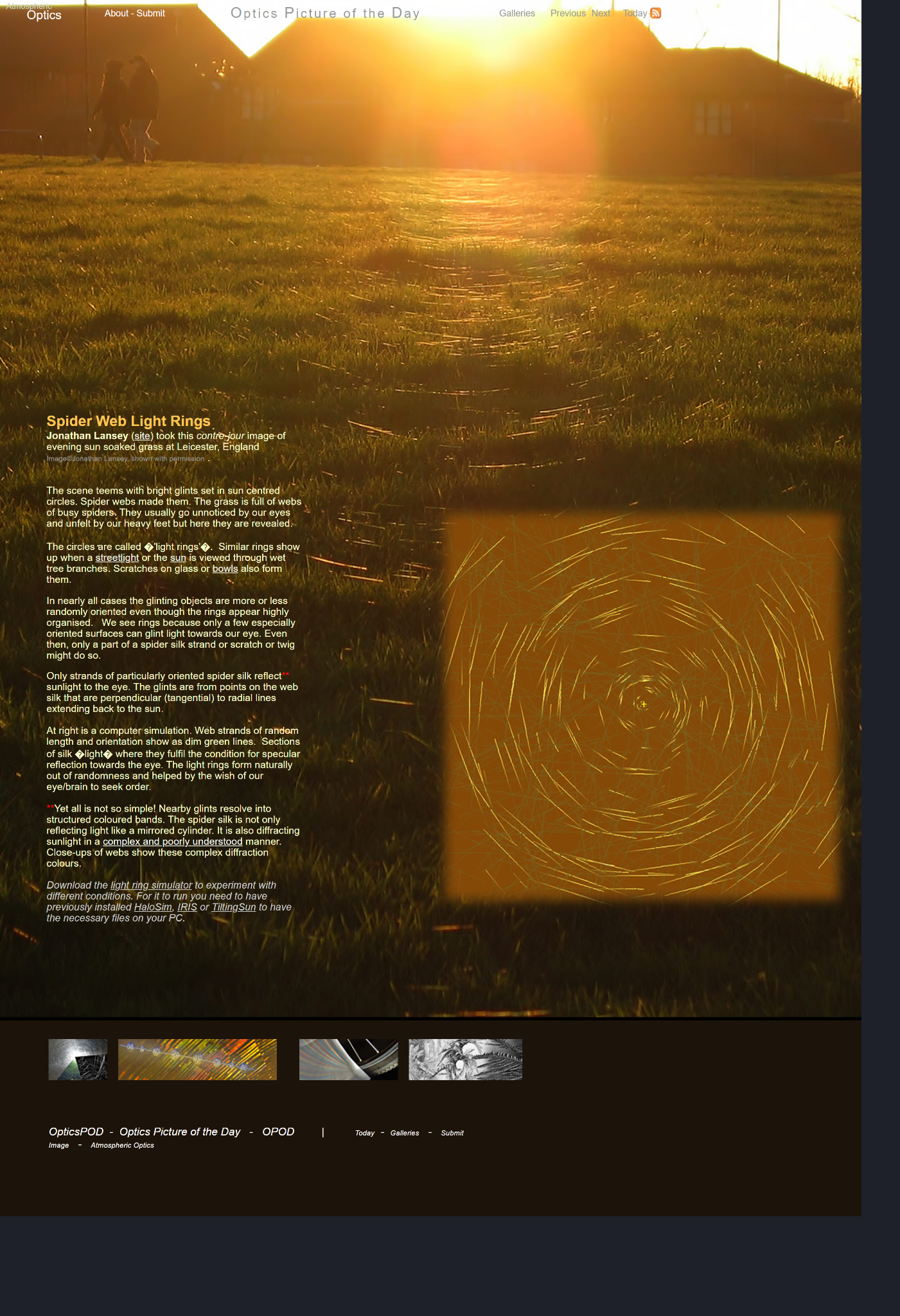OPOD - Spider Light Rings
OPOD - Spider Light Rings: Unveiling the Beauty of Nature's Web
When we think of spider webs, we often picture intricate designs spun between trees or in corners of our homes. But have you ever noticed the mesmerizing light rings that can be seen when the sun shines through these delicate strands? These enchanting circles, known as "light rings," add a touch of magic to our surroundings. In this article, we will delve deeper into the phenomenon of spider light rings and explore their fascinating intricacies.
Spider light rings can be observed when sunlight interacts with the spider silk strands within a web. These glints of light create circles that appear highly organized, even though the underlying objects responsible for the glinting are randomly oriented. Similar rings can also be seen when sunlight passes through wet tree branches, scratches on glass, or even bowls.
The formation of light rings is a result of the unique properties of spider silk. Only strands of spider silk that are particularly oriented have the ability to reflect sunlight towards our eyes. The glints of light are produced by points on the silk strands that are perpendicular to radial lines extending back to the sun. This alignment allows for specular reflection, creating the mesmerizing light rings we observe.
To better understand the formation of light rings, computer simulations have been conducted. These simulations reveal that web strands of varying lengths and orientations contribute to the creation of the rings. The random nature of the strands, combined with the inclination of our eyes and brain to seek order, gives rise to the organized appearance of the light rings.
However, the story behind spider light rings becomes even more intriguing when we consider the presence of structured colored bands within nearby glints. It turns out that spider silk not only reflects light like a mirrored cylinder but also diffracts sunlight in a complex and poorly understood manner. Close-ups of spider webs reveal a captivating display of diffraction colors, adding an extra layer of beauty to these natural phenomena.
If you're eager to experiment with different conditions and explore the world of light rings further, you can download a light ring simulator. This tool allows you to simulate various scenarios and observe the effects of different parameters on the formation of light rings. To run the simulator, you will need to have previously installed software such as HaloSim, IRIS, or TiltingSun, as these programs provide the necessary files for the simulation.
In conclusion, spider light rings offer us a glimpse into the hidden wonders of nature's web. These captivating circles, formed through the interaction of sunlight and spider silk, remind us of the intricate beauty that surrounds us. The random orientation of the glinting objects, combined with the fascinating diffraction properties of spider silk, gives rise to the mesmerizing patterns we observe. So next time you come across a spider web glistening in the sunlight, take a moment to appreciate the enchanting spectacle of spider light rings.

Spider Web Light Rings
Jonathan Lansey (site) took this contre-jour image of evening sun soaked grass at Leicester, England
Image©Jonathan Lansey, shown with permission .
The scene teems with bright glints set in sun centred circles. Spider webs made them. The grass is full of webs of busy spiders. They usually go unnoticed by our eyes and unfelt by our heavy feet but here they are revealed.
The circles are called �'light rings'�. Similar rings show up when a streetlight or the sun is viewed through wet tree branches. Scratches on glass or bowls also form them.
In nearly all cases the glinting objects are more or less randomly oriented even though the rings appear highly organised. We see rings because only a few especially oriented surfaces can glint light towards our eye. Even then, only a part of a spider silk strand or scratch or twig might do so.
Only strands of particularly oriented spider silk reflect.. sunlight to the eye. The glints are from points on the web silk that are perpendicular (tangential) to radial lines extending back to the sun.
At right is a computer simulation. Web strands of random length and orientation show as dim green lines. Sections of silk �light� where they fulfil the condition for specular reflection towards the eye. The light rings form naturally out of randomness and helped by the wish of our eye/brain to seek order.
..Yet all is not so simple! Nearby glints resolve into structured coloured bands. The spider silk is not only reflecting light like a mirrored cylinder. It is also diffracting sunlight in a complex and poorly understood manner. Close-ups of webs show these complex diffraction colours.
Download the light ring simulator to experiment with different conditions. For it to run you need to have previously installed HaloSim, IRIS or TiltingSun to have the necessary files on your PC.
Note: this article has been automatically converted from the old site and may not appear as intended. You can find the original article here.
Reference Atmospheric Optics
If you use any of the definitions, information, or data presented on Atmospheric Optics, please copy the link or reference below to properly credit us as the reference source. Thank you!
-
<a href="https://atoptics.co.uk/blog/opod-spider-light-rings/">OPOD - Spider Light Rings</a>
-
"OPOD - Spider Light Rings". Atmospheric Optics. Accessed on April 28, 2024. https://atoptics.co.uk/blog/opod-spider-light-rings/.
-
"OPOD - Spider Light Rings". Atmospheric Optics, https://atoptics.co.uk/blog/opod-spider-light-rings/. Accessed 28 April, 2024
-
OPOD - Spider Light Rings. Atmospheric Optics. Retrieved from https://atoptics.co.uk/blog/opod-spider-light-rings/.